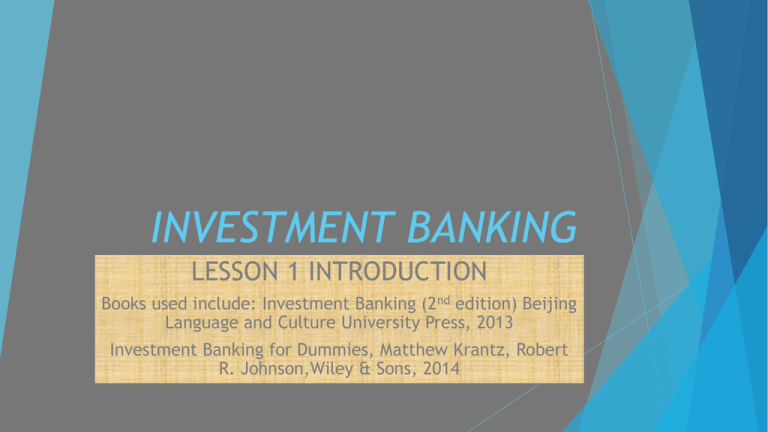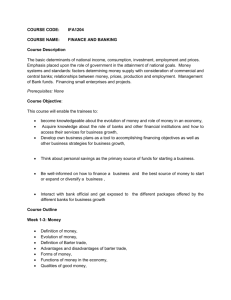investment banking
advertisement

INVESTMENT BANKING LESSON 1 INTRODUCTION Books used include: Investment Banking (2nd edition) Beijing Language and Culture University Press, 2013 Investment Banking for Dummies, Matthew Krantz, Robert R. Johnson,Wiley & Sons, 2014 LESSON 1 INTRODUCTION Like what we have already learned at a basic level, all banking is moving money from people who have it, savers, lenders (investors) to those who need it, borrowers, spenders (issuers). However, investment banking is much more than just deposits and loans offered by the commercial banks. REVIEW – DISCUSSION ACTIVITY Let’s do a little review from your last course with me. In your groups, discuss these questions. 1. What are the 2 main types of Financial Intermediaries? 2. What are their primary responsibilities? 3. What separated them and what brought them back together? What are some of the reasons the two types of banks were separated in the United States years ago? LESSON 1 – TOPICS FOR TODAY 1. SIMPLY, WHAT IS INVESTMENT BANKING (IB)? 2. WHAT ARE THE ACTIVITIES OF INVESTMENT BANKS? 3. EMPLOYMENT BY JOB FUNCTION 4. IB SALARIES 1. WHAT IS INVESTMENT BANKING & WHAT ARE THE ACTIVITIES OF INVESTMENT BANKS? Simply, investment banking is what investment banks do? An investment bank is a financial intermediary or institution that helps corporations raise funds. How do they do this? 2. WHAT IS INVESTMENT BANKING & WHAT ARE THE ACTIVITIES OF INVESTMENT BANKS? Major Functions of Investment Banks A. Raising Capital and Security Underwriting B. Financial Advisory (M & A) C. Corporate Lending D. Sales & Trading E. Brokerage Services F. Research G. Investments A. RAISING CAPITAL AND SECURITY UNDERWRITING 保险业 Bǎoxiǎn yè Investment banks are middlemen between companies that want to start or grow a business and the buying public. Between issuers and investors. Investment banks are the financial intermediaries that these companies want to hire. Simply, they generate money from investors by selling shares of stock or debt A. RAISING CAPITAL AND SECURITY UNDERWRITING 保险业 Bǎoxiǎn yè The investment bank will determine the value and the risk level of the business in order to price, underwrite and sell securities through the primary or secondary market. QUESTIONS FOR GROUP DISCUSSION 4. What is underwriting? 5. What is the difference between the primary and secondary market? 6. What is an IPO? P. 57 CH 4 Can you give an example of one? WHAT IS UNDERWRITING? The process by which investment bankers raise investment capital from investors on behalf of corporations and governments that are issuing securities (both equity and debt). Explanation: The word "underwriter" is said to have come from the practice of having each risktaker write his or her name under the total amount of risk that he or she was willing to accept at a price. Each investment banking firm takes the responsibility (and risk) of selling its specific amount of equity or debt. GROUP ACTIVITY Alibaba wants to raise some money for a new project. What can they do? Think primary and secondary market. Sample from wall st prep UNDERWRITING EXAMPLE Jingdong wants to raise some money for a new project. One option is to issue more stock through the secondary market. They’ll go to an investment bank like JPMorgan, which will price the new shares (investment banks are experts at calculating what a business is worth). JPMorgan will then underwrite the offering, meaning it guarantees that Jingdong receives proceeds at $(share price * newly issued shares) less JPMorgan’s fees. Then, JPMorgan will use its salesforce to go out and get Fidelity and many other institutional investors to buy chunks of shares. JPMorgan’s traders will help the buying and selling of these new shares by buying and selling Jingdong shares out of their own account, i the Jingdong offering. thereby making a market for B. FINANCIAL ADVISORY (M & A) The Investment bank helps a company or government make decisions on managing their financial advise resources. This advice may include whether to buy another company or sell off part of the business. So, the investment bank will be involved in mergers and acquistions (M & A) advisory B. MERGERS AND ACQUISITONS (cont) Banks advise buyers and sellers on business valuation (how to value a business and determine what it is worth), negotiation, pricing and structuring of transactions, as well as procedure and implementation. Valuation 计价 Jìjià Negotiation 谈判 Tánpàn Structuring 结构 Jiégòu Transactions 交易 Jiāoyì B. MERGERS AND ACQUISITONS (cont) Important source of fee income for investment banks. Higher than underwriting fees. This is why M&A bankers are some of the highest paid and highest profile bankers in the industry. We will look at investment banker salaries later. C. CORPORATE LENDING Investment Banks (IB) help companies and other large borrowers sell securities to raise money. Sometimes they make loans to their customers, often short term loans, called bridge loans to help a company for a time while another deal is in the making. D. SALES & TRADING Institutional investors such as pension funds, mutual funds, life insurance firms as well as hedge funds use investment banks in order to trade securities. Investment banks match up buyers and sellers as well as buy and sell stocks and other financial instruments out of their own account. For these services, investment banks charge commission fees. D. SALES & TRADING (cont) Once the new securities are priced and underwritten, Investment banks like JP Morgan has to find buyers for the newly issued shares in both the primary and secondary market. SALES - A firm’s sales force is responsible for providing information about certain securities to institutional investors. D. SALES & TRADING (cont) TRADING - Traders are the final link in the chain, buying and selling securities on behalf of these institutional clients and for their own firm in anticipation of changing market conditions and upon any customer request. E. BROKERAGE SERVICES Some Investment banking operations include brokerage services where they may hold customers’ assets or help them conduct trades. F. RESEARCH Investment Banks not only help large institutions sell securities to investors, but also assist investors looking to buy securities. Many investment banks run research units that advise investors on whether they should buy a particular investment. TERM UNDERSTANDING The terms INVESTMENTS, SECURITIES or STOCKS and BONDS, or even FINANCIAL INSTRUMENTS pretty much mean the same thing. G. INVESTMENTS – PRIVATE EQUITY As mentioned early, investment bankers serve the role of a middleman between the firms or companies that need money and those that have it. But, sometimes investment banking operations may invest their own money in companies or projects that look good. This type of investment, often made in companies that don’t have investments that the public can buy, is called private equity. 3. EMPLOYMENT BY JOB FUNCTIONS – Investment Bank Organizational Structure FRONT OFFICE - The front office generates the bank’s revenue and consists of three primary divisions: investment banking, sales & trading and research. INVESTMENT BANKING - Investment banking is where the bank helps clients raise money in capital markets and also where the bank advises companies on mergers & acquisitions. 3. EMPLOYMENT BY JOB FUNCTIONS – Investment Bank Organizational Structure (cont) SALES & TRADING - sales and trading is where the bank (on behalf of the bank and its clients) buys and sells products. Traded products include anything from commodities to derivatives, like options and swaps. RESEARCH -Research is where banks review companies and write reports about future earnings. Other financial professionals buy these reports from these banks and use the reports for their own investment analysis. 3. EMPLOYMENT BY JOB FUNCTIONS – Investment Bank Organizational Structure (cont) MIDDLE OFFICE - includes risk management, financial control, corporate treasury, corporate strategy, and compliance. The goal of the middle office is to ensure that the investment bank doesn’t engage in certain activities that could be harmful to the bank’s overall health as a firm, by taking on too much risk. 3. EMPLOYMENT BY JOB FUNCTIONS – Investment Bank Organizational Structure BACK OFFICE - Includes operations and technology. The back office provides the support so that the front office can do the jobs needed to make money for the investment bank. 4. INVESTMENT BANKING SALARIES First Year Investment Banking Analyst (2015) Base: $85k (up from $70k in 2014) Bonus: $55-$75k (2014 data) Second Year Investment Banking Analyst (2015) Base: $90k (up from $80k in 2014) Bonus: $75-$95k (2014 data) Third Base: Year Investment Banking Analyst (2015) $90k-$100k ($90k in 2014) Bonus: $95-$115k (2014 data) 4. INVESTMENT BANKING SALARIES (cont) First Year Investment Banking Associate (2015) Base: $110-$125k Bonus: $80-$100k (2014 data) Beyond At First Year Associate the associate level, compensation starts to vary more widely. At the highest end, associates can make as much as $250k. The next level up is Vice President, which make up to $400k. Highest on the food chain is the Managing Director, who can make anywhere from 500k to several million dollars.






